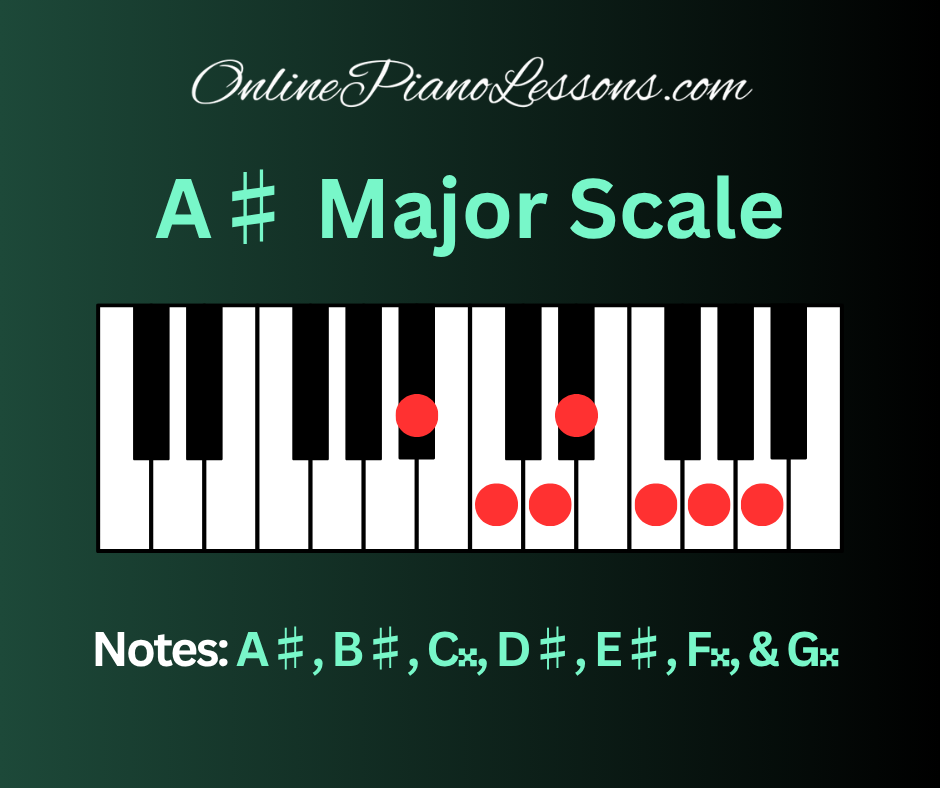
Scales are the backbone of music theory, and they give musicians the foundation needed to understand melodies, harmonies, and chord progressions. Among the many scales, the A sharp major scale stands out as an unusual case. While it technically exists, pianists and composers rarely use it because of its theoretical complexity. Instead, its enharmonic twin—the B flat major scale—is almost always preferred.
Still, learning about the A♯ major scale is a great exercise in sharpening your knowledge of music theory and improving your ability to navigate the piano. Let’s take an in-depth look at this rare but fascinating scale.
Quick Preview: The A sharp major scale (also written as the A♯ major scale) is one of the more complex scales to understand and play on the piano due to its use of double sharps. While rarely seen in practice, it’s a fascinating scale that highlights the depth of music theory. This guide will break down how the A sharp major scale works, how to find it on the piano, and why it exists despite being uncommon in real-world compositions.
What is the a Sharp Major Scale?
The A sharp major scale is built using the standard pattern of whole steps (W) and half steps (H) that defines every major scale:
W – W – H – W – W – W – H
Starting on A♯, and applying this formula, gives us:
- A♯ → B♯ → C𝄪 → D♯ → E♯ → F𝄪 → G𝄪 → A♯
At first glance, you can see why this scale is rarely used—several notes require double sharps, making it confusing to read and write. Nevertheless, it is a valid major scale under music theory.
Why the A♯ Major Scale is Rare
On the piano, the A♯ major scale is much harder to read than its enharmonic equivalent, the B♭ major scale. B♭ major only contains two flats (B♭ and E♭), which makes it far simpler to use in notation and practical playing.
Because of this, composers almost always opt for B♭ major instead of the A♯ major scale. However, the A♯ version may appear in theoretical exercises, key signature discussions, or specific modulations where it serves a temporary role.
How to Find the a Sharp Major Scale on Piano
To play the A♯ major scale on the piano, follow these steps:
- Start with the note A♯ (the black key immediately to the right of A).
- Apply the major scale formula: W – W – H – W – W – W – H.
- This gives you the following keys:
- A♯ (start)
- B♯ (which is played as the same key as C)
- C𝄪 (which is played as the same key as D)
- D♯
- E♯ (same as F)
- F𝄪 (same as G)
- G𝄪 (same as A)
- A♯ (octave)
So while the written notes may look complicated, the actual keys on the piano overlap with much more familiar ones.
The Sound of the a Sharp Major Scale
Despite its complexity in notation, the A♯ major scale sounds no different from the B♭ major scale. They are enharmonic equivalents, meaning they are built from the same physical piano keys but named differently.
The sound of this scale is bright, joyful, and resonant—typical of all major scales. If you play the A♯ major scale on the piano, your ear will likely recognize it more as the familiar sound of B♭ major.
Chords Built from the A♯ Major Scale
Just like with any scale, you can build chords on each degree of the A♯ major scale. These chords follow the standard major key sequence:
- A♯ major (I)
- B♯ minor (ii)
- C𝄪 minor (iii)
- D♯ major (IV)
- E♯ major (V)
- F𝄪 minor (vi)
- G𝄪 diminished (vii°)
Again, while these chord names may look overwhelming with double sharps, they correspond to more familiar chords when played on the piano.
Key Signature of the a Sharp Major Scale
The A♯ major scale has a key signature with 10 sharps, including double sharps. This is the main reason it is avoided in real-world notation. Instead, composers choose enharmonic equivalents that are easier to read, such as B♭ major or F major.
Why Learn the A♯ Major Scale?
You might wonder why anyone should bother learning the A♯ major scale at all if B♭ major is so much easier. Here are a few reasons:
- Theoretical Understanding – It helps deepen your knowledge of enharmonic notes and key signatures.
- Advanced Practice – Working through unusual scales strengthens your music reading and piano skills.
- Compositional Awareness – Some advanced pieces may briefly modulate into keys that are easier to think of as A♯ major.
- Sharper Sight-Reading – Being exposed to double sharps and unusual notation improves your ability to adapt while reading sheet music.
Conclusion
The A sharp major scale is a fascinating but rarely used key in music theory. While its notation is full of double sharps and complex spellings, it offers the same sound as the B♭ major scale on the piano. For practical purposes, musicians almost always choose B♭ major, but exploring the A♯ major scale can strengthen your theoretical knowledge and deepen your understanding of how scales work in different contexts.
FAQ
1. What is the A sharp major scale?
It’s a major scale built starting on A♯ using the pattern W – W – H – W – W – W – H.
2. Why is the A♯ major scale rarely used?
Because it requires multiple double sharps, making it hard to read and write compared to B♭ major.
3. How do you play the A♯ major scale on piano?
Start on A♯ and follow the major scale step pattern, which overlaps with the notes of the B♭ major scale.
4. What is the key signature of the A♯ major scale?
It technically has 10 sharps, including double sharps, which is why it’s impractical.
5. What is the enharmonic equivalent of A♯ major?
B♭ major, which sounds the same but is much easier to notate and play





 Hi, I'm Thomas, Pianist Composer,
Hi, I'm Thomas, Pianist Composer,  I love playing piano, creating new melodies and songs, and further developing my online piano course and making updates/additions to my site OnlinePianoLessons.com!
I love playing piano, creating new melodies and songs, and further developing my online piano course and making updates/additions to my site OnlinePianoLessons.com!  Now that is what I call fun!
Now that is what I call fun!





